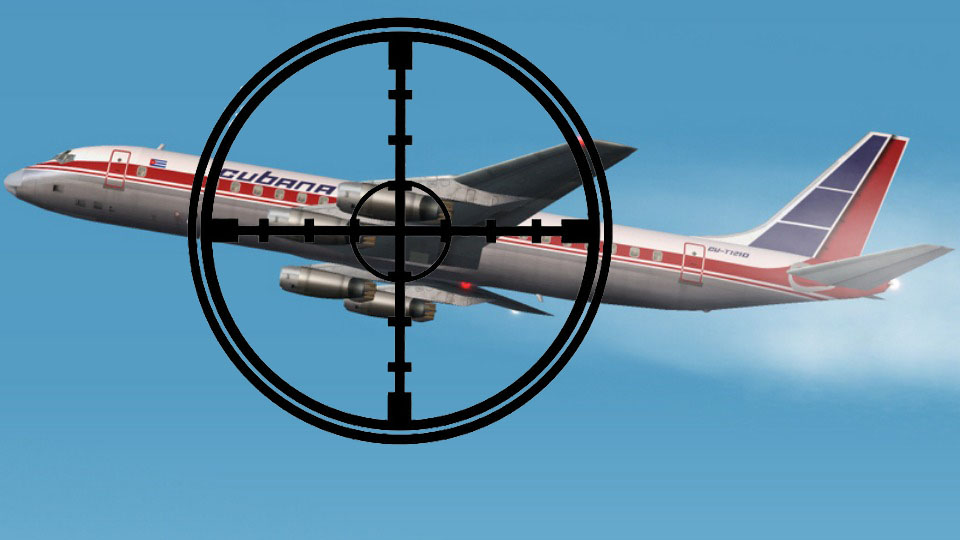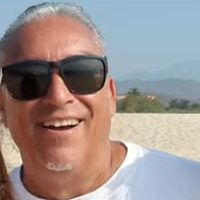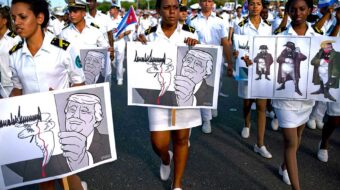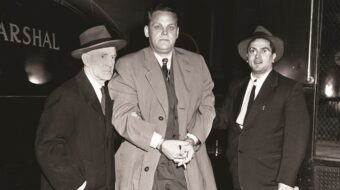
On October 6, 1976, Cubana de Aviación Flight 455 took off from Barbados en route to Jamaica. It soon disappeared from the radar screens. An investigation by various aviation agencies, including the Cuban government, determined that the airliner was tragically blown up in midair. Two hidden explosive devices had been placed on the airplane. When the bombs detonated, the plane was ripped apart and plummeted into the ocean below.
Everyone aboard perished: 73 passengers and crew died in this atrocious act of terrorism. Innocent men, women, and children lost their lives, including the entire Cuban Olympic fencing team. Debris from the airliner scattered for miles and filled the clear blue ocean with what was left of Flight 455.
For years, it has been assumed that the CIA assisted Cuban exile terrorists in planting the
bombs that destroyed the plane. A new informative and well-researched documentary, Cubana 455, details the ties between the CIA and Cuban exile terrorists. The film highlights interesting interviews with the relatives of those who lost their lives, government officials, and exile terrorists themselves. In this extraordinary documentary, it is clear that the Cuban terrorists have no remorse and consider civilian deaths as only collateral damage in their campaign against the Castro government.

Filmmaker Enrique Berumen has researched, written, and directed this documentary based on this tragic event. He is a retired California State University-Los Angeles film professor and filmmaker and travels back and forth from Cuba to the United States for educational purposes, including filmmaking activities.
Today, the tragic events of October 6, 1976, and other terrorist acts still resonate with the Cuban people. Berumen is scheduled to premiere the new documentary in Cuba on October 6, 2021, the 45th anniversary of the crime. A U.S. national tour is planned, including submitting the documentary for upcoming U.S. film festivals.
Berumen is currently in the United States planning and promoting the upcoming U.S. tour. He sat down for a brief interview and took time to answer a few questions. The discussion has been condensed and edited for clarity.
David Trujillo: Enrique, can you give us a brief description of your background and your expertise in filmmaking?
Enrique Berumen: I took my first film class as an undergrad at UC Santa Cruz with Dr. Julianne Burton, who became my mentor in Latin American film. Through her, I applied for the International Film and TV school in Cuba. It was a brand new project of the Latin American Film Foundation headed by Gabriel García Márquez. At the time, it was called La Escuela de Tres Mundos, the School of Three Worlds, because it took only students from Latin America, Africa, and Asia. I qualified to apply as a Chicano—a member of a Third World community within the U.S. empire. Once you passed the entrance exam, the school provided you with everything except airfare. That was the first time I took film production courses. I was part of the second generation at the school.
Obviously, this film school was within the context of a socialist Cuba in a world divided into two camps. The dream of a Third World cinema was to tell our stories from our point of view. This was the late 1980s. We were in a bipolar world then. We were not subject to this unipolar world dominated by the U.S and NATO. I later got my M.F.A. in screenwriting from USC. I wrote several feature-length scripts that got me far, but not far enough to get them produced. I was married and had a child and needed to make a living. Having been an educator in different capacities, I ended up teaching screenwriting for 23 years at California State University Los Angeles. Had I not been a full-time professor, who knows how I’d make a living? I enjoyed my years at CSULA because I did my general education there in the 1980s and most students were like me: the first in their working-class family to go to an institution of higher education. Somehow life takes you where you have to be and not necessarily where you want to be.
How would you describe your new documentary? Why is it important and what would you like the public to take away after seeing it?
It is an activist, anti-terrorism documentary, a piece that speaks of CIA terrorism, which is always obscured and under the radar in mainstream media. This documentary sheds light on the first bombing of a civilian airplane in flight. Very few people know about this hideous event. It truly is a crime against humanity. Everyone knows about Pan Am 103 and 9/11. For those crimes, the U.S. rolled out their big guns. They punished Libya, Iraq, and Afghanistan. But the Cubana 455 crime went unpunished. And how could it be? It was done by CIA-trained agents, so the U.S. simply ignored it. The mainstream media ignored it. Who cares, right? Just a bunch of Cubans who lived in Cuba died. Who cares?
Terrorism is terrorism. A war, declared or not, should not include targeting civilians, and this is what Cubana 455 was: a civilian plane with 73 human beings.
Ultimately, the documentary makes a call for justice—for the public to be active, to reassess what is terrorism, and view October 6, 1976, as a day of infamy, a crime against humanity. The only thing left to do now is to have people in the U.S. and around the world know what happened on October 6th. That day should be remembered as the first 9/11 in the Americas.
The call of Cubana 455 is to advocate for October 6th to become International Day Against Terrorism. It is an idea that David Comissiong, Ambassador of Barbados to the Caribbean Community (CARICOM), has been proposing for a few years. It’s a long uphill road, but it is the least we can do for those innocent victims of terrorism and bring some closure to the pain of injustice and impunity that the whole of Cuba feels, especially the families of the victims. My hope is that audiences are moved to the point of taking action and put down a grain of justice for the victims of October 6th.
Before I ask you questions regarding the process of making the film, I think it’s important to get your take on how Cuban officials felt about you making this documentary. Were they supportive or not? Give us some indication of what the overall process was in making the film. I know it was a long and difficult one, so tell us about it.
This project took more than 15 years to complete. Part of the problem was funding. The project involved traveling to different countries. And then life happened—the good and bad of life. There were years that the doc was shelved, and I thought it would never get finished. In 2017, I approached ICAIC, the Cuban Film Institute, about helping with the project. We needed tons of archival footage from Cuban sources, and it would cost us thousands of dollars to secure rights. ICAIC gave us access to any archive we needed for free. Plus, we filmed the epilogue of the documentary in 2018 in Cuba, a sort of update of the Cubana 455 case. Cuba, being under a ferocious U.S. blockade since 1962, had no money to offer us (plus the U.S. Trading with the Enemy Act would impede this anyway). But all their in-kind services were the missing links to being able to finish this project of 15 years and more than $250,000 spent.
I would say that ICAIC’s support was crucial, indeed. But its moral support was even more significant. ICAIC is a historical institution: The first revolutionary decree, in March 1959, two months after the triumph of the Cuban Revolution, was the creation of ICAIC in order to have a national cinema, a national memory, a place where an oppressed Latin America can show its stories from its point of view. You are talking about alternative media by a revolutionary government in 1959—a new revolution that understood the value of culture and the arts in the new society being formed. That is historical.
Just as historical is the fact that Cubana 455 is being the first Chicano-Cuban co-production ever. In 1979, ICAIC founded the Latin American Film Festival. In that first festival, there was a Chicano cinema retrospective. My producer, David Sandoval, was there. That is another historical moment: Chicano cinema getting exposure south of the border. After all, we Chicanos are part of that Patria Grande (Bolivar called America the great country). Despite the U.S. gobbling half of Mexico in 1848, we are still part of La Patria Grande. Despite the walls, the borders, we are all Americanos.
That is part of ICAIC’s legacy: to create La Patria Grande via cinema—a whole continent free and independent. That is Cuba’s great crime, to be free and independent, to not have a master, be it Spanish or Gringo. So within that context, Cubana 455 is only a continuation of that 1979 Chicano-Cuban connection and hopefully the first of many projects between us and them.
What were the main problems in getting this documentary finished? What were your concerns about filming, editing, getting the film into the US., etc.?
When I stumbled upon this story, I was in Las Tunas (in eastern Cuba). It was September 2001. I stumbled into the museum of Carlos Leyva there; he was a 20-year-old fencer on the plane. I was moved by his story and thought that the Cubana 455 story would make a good documentary. Two days later, the 9/11 attack happened.
9/11 put a damper on my project because the pro-empire hysteria made it impossible to get funding for a story about terrorism that didn’t have the U.S. as the victim. If you remember, from 2001 to 2006, if you criticized the U.S. empire, you were crucified as un-American. The media was on this bandwagon of us versus them. Even the New York Times would not print the word “torture.” Instead, they used “interrogation.” I remember reporters saying they were Americans first and journalists second. It was such a stifling ambiance. It was such a depressing time to be anti-war and anti-imperialist. I remember people full of hate and happy that Iraqis were being murdered and their country destroyed.
As time went on, we had individual donors, and we got a grant from the now defunct Paul Robeson Media Fund based in New York. It was a very slow and painful start. Over the years, we filmed when we could. It was mostly on and off. When there were some funds, there was no time, or if there was time there were no funds. The game-changer was in 2017, as I mentioned earlier when we approached ICAIC for support and got it. It has been a long journey, but our commitment to the truth and for justice was strong and the documentary is finally done.
Is there one interesting story you can tell that you went through while making this documentary?
There are many good anecdotes over the years of production, like meeting Phillip Agee, the ex-CIA agent who died an exiled American in Cuba. Interviewing Luis Posada Carriles while he was in prison. Looking for and finding one of the material authors in Caracas. Feeling the pain of the family members as if 1976 had just happened the day before. Meeting lawyer José Pertierra and Ambassador Comissiong. Going to Barbados and standing right in front of where the plane went down. The traveling always took a lot of planning because funds were limited, but we still managed to treat the crew members in different cities with dignity.

I will tell you that one thing that sticks out the most was the editing in Havana. It took two years because the pandemic interrupted the work for a whole year. My Cuban producer would arrange for me to be dropped off at the editor’s studio in the morning. We would have lunch and work until 5 or 6 p.m. I got to know his wife and daughter. We built a family relationship out of the endless days of editing.
I would walk back to my lodging as the sun went down. It was a good six-mile walk. People were on their way home from work. I felt part of that human wave of Cuban common folks. Here I was, a citizen of the country that has been so aggressive toward their country—even during the pandemic Trump tightened the embargo by prohibiting family remittances from the U.S.; Biden has not reversed this!—and there I was in Martí’s and Fidel’s Cuba finishing this project for a just cause, for a little great country that has done so much for the Third World in different respects, walking, soaking in sweat, feeling like I was part of this socialist nation.
On the last day of editing, I sat in a park. I sipped some café and smoked a Montecristo (Che’s cigar of choice), and I looked at Avenida Paseo with the sea beyond the greenery. I took a deep breath and said, “Gracias, Cuba; gracias, Fidel, for your moral compass.” And now comes the other phase of the project: exhibition.
What are your plans after the Cuban premiere?
The documentary will screen privately on October 6th in Cuba (if the pandemic does not have a spike there), mostly for the families of the victims and some Cuban mass organizations. The actual public screening there will be in December for the Havana Film Festival.
During what is left of 2021 and in 2022, we will be submitting it to film festivals in the U.S. and internationally. Eventually, it will broadcast on Cuban TV and Telesur, and it will stream online. We hope some local U.S. stations will be interested in broadcasting it. But for now, we hope it is shown at film fests so we can network and get the word out on the October 6th campaign.
Yes, we still have a couple of years of work ahead of us but that is how alternative/non-commercial media works: you mostly do all the work ’cuz, well, mainstream outlets don’t really care about these types of stories that rock the boat. I mean, I can’t remember a fiction film where the CIA was the bad guy. That doesn’t happen in Hollywood, does it? Theirs is a convoluted, skewed truth for binge watching and entertainment. But hey, here we are, just gotta keep going forward no matter what. Pa’lante!
I know that a Los Angeles screening will take place sometime in June so we look forward to seeing your new documentary. Gracias.
The L.A. screening will take place Sat., June 19 at 1251 S. St. Andrews Pl. (2 blocks west of Western and only accessible from Pico Blvd.) at 2 pm, with live music by Primero de Mayo and a Q&A following the screening. There will be one intermission at 3:30 pm. Admission is by reservation only! Contact dtmrt1@gmail.com to reserve.












Comments